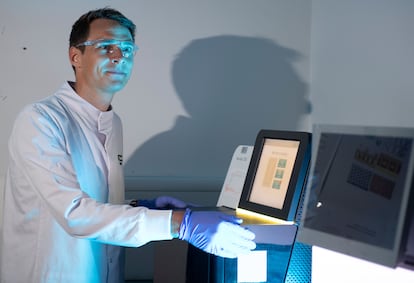“I thought it was the beginning of a new stage and it’s almost the end,” admits Manuel Carrasco, a 59-year-old municipal employee in Seville, sadly. He entered the hospital at the beginning of the summer to have a catheter removed after cancer treatment. Within hours, sepsis, an extreme reaction to an infection caused by this simple intervention, took him to the ICU. A month later he left the hospital after suffering amputations of his fingers due to the effects of the attack, which did not initially respond to conventional treatments. Avoiding these conditions and the 700,000 deaths caused by cancer is a difficult task. World Health Organization It is estimated that antibiotic-resistant bacteria are causing deaths each year. It is a race against time for which two investigations published in Cell They have opened up new pathways that are within us: the microbes we live with (39 trillion) and those that come with everyday food. They all have an unknown arsenal that they use to reside, interact and defend themselves. And those weapons can be very useful.
César de la Fuente, a 38-year-old Spanish biotechnologist who runs a laboratory bearing his name at the University of Pennsylvania, has spent his entire research life searching for effective antibiotics to replace existing ones, which bacteria learn to resist. He has found potential molecules in our ancestors, the Neanderthals, in extinct species, such as the mammoth, and almost a million new antibiotics in the global microbiome, according to a recent article published in Cell. New research in collaboration with Professor Ami Bhatt and his team at Stanford, Also published by Cellhas brought the search closer to ourselves and explored our skin and our digestive system, which are natural habitats for this microscopic universe.
“In our bodies there are trillions of microbes competing for space, forced to attack and defend each other in order to survive in an extremely hostile environment. It is a chemical war in which the protagonists are the microbes. We think that this environment is conducive to innovation, allowing microbes to produce new compounds,” he explains by telephone shortly before giving a lecture on his findings in Florence (Italy), where he has also been awarded the Bodanszky Prize.
As with the DNA fragments that were initially considered useless and that little by little reveal their reason for being, De la Fuente has focused on all the small open reading frames (smORF, acronym in English for small open reading frame). “They are little pieces (genetic sequences) that were previously thought to do nothing, to have no biological function,” he simplifies to explain. “But when we analysed them,” he adds, “we discovered that they encode antibiotic molecules, which are functional.”
By computationally analyzing 444,054 proteins from nearly 2,000 human microbiomes, the teams from the University of Pennsylvania and Stanford have found more than 300 candidates with antibiotic capacity, of which they have selected 78. 70% of them work in laboratory cultures and the most promising have shown efficacy in preclinical mouse models. “The activity of some of these molecules is comparable to that of existing antibiotics,” he highlights. “We have named the most favorable molecule prevotelin and it is produced by the intestinal microbe.” Prevotella copious“It’s fascinating to think of microbes as pharmacies that produce compounds that can benefit humans,” he explains.
“Another interesting thing is that we saw that the molecules can modulate communities of beneficial bacteria. We think they could act on the human microbiome to reprogram these communities,” he adds.
Microbes in food
César de la Fuente’s study has preceded another one, with Spanish participation and published also for Cellwhere researchers have developed for the MASTER EU consortium a database of the “food microbiome” by sequencing the metagenomes of 2,533 different foods. The work identifies 10,899 food-associated microbes, half of which were previously unknown species. These food-associated microorganisms represent 3% of the intestinal microbiome of adults and 56% of the intestinal microbiome of infants.
“This is the largest study of microbes in food,” says co-author and computational microbiologist Nicola Segata of the University of Trento and the European Institute of Oncology in Milan. “We can now start using this reference to better understand how the quality, preservation, safety and other characteristics of food are related to the microbes they contain.”
The team analyzed food-associated metagenomes from 50 countries; 65% from dairy sources, 17% from fermented beverages, and 5% from fermented meats. In addition to applications for improving food products, the researchers highlight that understanding the food microbiome can directly benefit human health because some of the microbes we eat can become permanent members of our own bodies.

De la Fuente highlights the importance of these studies, which complement the research he is conducting to identify and develop the most beneficial microbiome.
Cristian Díaz-Muñoz, a researcher at the Gastrointestinal Genetics Lab (CIC bioGUNE – BRTA), describes the database revealed as a “true atlas for any microbiologist and, therefore, a starting point for future research.”
In line with De la Fuente, the researcher from the Basque center highlights in Science Media Center (SMC) Spain: “The link between food microbiology and human microbiota confirms the popular saying that we are what we eat and reaffirms the foundations on which to base quality probiotic foods containing microorganisms with proven capacity to colonize the digestive tract and have a positive effect on intestinal health.”
Baltasar Mayo Pérez, CSIC Research Professor at the Institute of Dairy Products of Asturias, highlights to SMC that the work “represents the greatest scientific effort for the microbiological characterization of foods (…) using the latest generation of massive sequencing techniques and the most advanced computer tools.”
You can follow THE COUNTRY Technology in Facebook and X or sign up here to receive our weekly newsletter.



